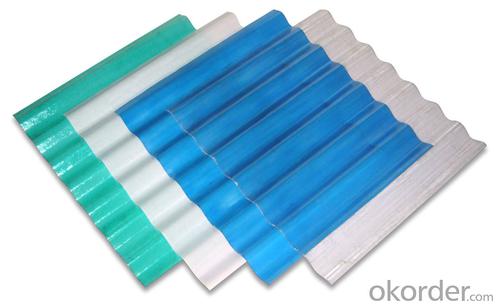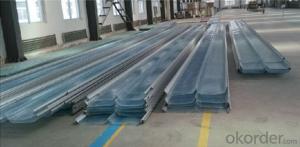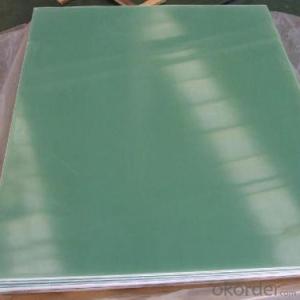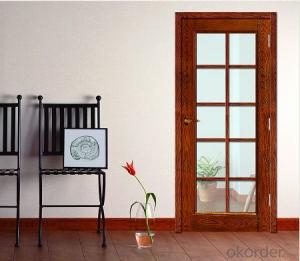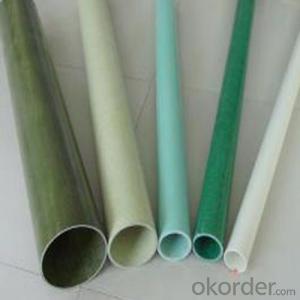FRP Pultrusion Profiles Fiber Reinforce Plastic Transparency Skylight Panel
- Loading Port:
- Qingdao
- Payment Terms:
- TT or LC
- Min Order Qty:
- 1000 m.t.
- Supply Capability:
- 10000 m.t./month
OKorder Service Pledge
OKorder Financial Service
You Might Also Like
Specifications
FRP Skylight Panel:
1,Energy-saving
2,Heat-resistant material
3,Insulated against noise
4,Good quality
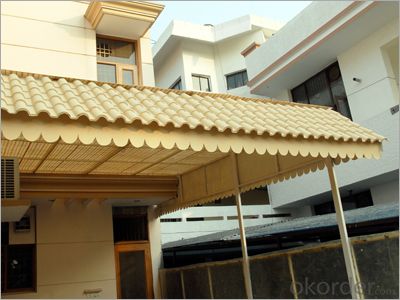
Features:
1) Owing to adopting continuous forming machinery, the length of theproducts is
not limited by product technique (except for transport equipment), any lengthand any section of panel can be made.
2) Excellent weather resistant property: surface is coated with ageingresistant film, which almost filters all UV light, the service life can be aslong as 20 years, greatly reduces the material cost and construction costbrought about by factors like the frequent change of PC boards
3) Good impact resistance and flexural strength make sure the translucentpanel can resist against the hit of hail and heavy typhoon
4) Excellent thermal stability: fiberglass panel belong to thermosettingfiber glass reinforced plastics, the thermal expansion coefficient is 2.2 x 10- 5cm/cmoc; PC (polycarbonate) are thermoplastics, the thermal expansion coefficientis 6.8 x 10 - 5cm/cmoc. When applied in big span buildings, the relativedisplacement of PC panel are too big, which results in the cracking andbreakage of hole position of screws, water leakage is virtually unavoidable
5) Fiberglass translucent panel are designed more personalized: FRP isheterogeneous material which can transform the direct light into diffusedlight, make the bright sunshine soft light friendly to man's eyes. The diffusedlight creates a comfortable working space (better effect in the region
6)General panels like PC, create direct light , which make the brightnessin the room uneven and cause man's eyes fatigued, overfocus makes floor orobjects change colors.
Heatnsulating property. The K (heat transfer coefficient) is small as2.0W/m2K. According to the test report issued by National Center forQuality Supervision & Test of Building Engineering (No.:BETC-QC1-2009-304R, refer to GB/T8484-2008), the result shows GRP of thicknessof 50mm, K is 2.0W/m2K.
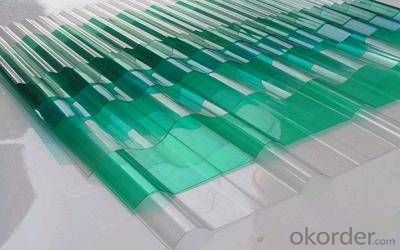
Fire resistance: class B. According to the test repot issued by National Center for Quality Supervision & Test of Fire Equipment (No.: Zb200921913), refer to GB8624-2006, the result achieves class B.
Smooth surface, up to 85% in light transmittance. According to the test report issued by National Center for Quality Supervision & Test of Building Engineering (No.:BETC-QC1-2009-305G), refer to GB/T2680-1994, GRP of thickness of 50mm, the transmittance is up to 85%. In sunny days, the illumination indoors can reach to 1000 lux. Refer to DIN 5035, the illumination in public place just needs 500 lux, and 200 lux is enough in workshop. Though it is high in transmittance, light pollution is not existed.
Sound isolation: 28dB. According to the test report issued by National Center for Quality Supervision & Test of Building Engineering (No.:BETC-QC1-2009-304S), refer to GB/T50121-2005, GRP of thickness of 50mm, sound isolation is 28dB.
Wonderful mechanical performance, which is shown in high elasticity and impact resistance. According to the test report issued by National Center for Quality Supervision & Test of Building Engineering (No.:BETC-QC1-2009-305DA), refer to GB/T9962-1999, result shows the vertical flexural strength is 131MPa, the lateral one is 124MPa, and the bending strength is more than 80MPa.
Long service life: at least 30years. GRP enjoys good performance in light and UV light resistance, and passed long-time exposure experiment.
High safety- hard to broken. Those doors, windows, curtain walls, partition panels, etc. used commonly in public areas, industrial plants and warehouses presently can be replaced to avoid maintenance in winter.
Light in weight: GRP of thickness of 50mm, it is 6.8Kg/m2 in weight.
It is of no pollution, and has good performance in erosion resistance (oxidation, acid, alkali, salt, oil and grease resistance). If destructive fire happens, GRP will be burned to be water, co2, co and dust, exclusive of nitride, sulfide, halogen or heavy metal. The product of combustion is low in toxicity, even lower than the one of pine, the result of smoke toxicity test is class ZA3.
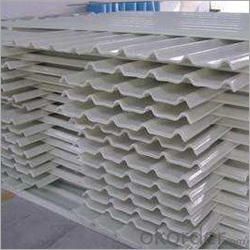
- Q: What are the typical applications for FRP pultrusion profiles?
- Some typical applications for FRP pultrusion profiles include structural components in the construction industry, such as beams, columns, and reinforcements. They are also used in the transportation industry for manufacturing lightweight and corrosion-resistant parts for vehicles and ships. Additionally, FRP pultrusion profiles find applications in electrical and power generation industries, as well as in the manufacturing of sports equipment and infrastructure.
- Q: Can FRP pultrusion profiles be used in the construction of pedestrian tunnels?
- Pedestrian tunnels can utilize FRP (Fiber Reinforced Polymer) pultrusion profiles. FRP is a lightweight and high-strength material that presents several advantages over traditional construction materials like steel or concrete. Corrosion resistance is a significant benefit of FRP pultrusion profiles in pedestrian tunnel construction. Unlike steel, FRP does not corrode when exposed to moisture or harsh environmental conditions. This is particularly valuable for underground structures like pedestrian tunnels, where water seepage or high humidity may pose concerns. Moreover, FRP pultrusion profiles possess exceptional mechanical properties, including high tensile strength and stiffness. Consequently, they can endure heavy loads and provide structural integrity to the tunnel. FRP's lightweight characteristic also simplifies handling and installation, ultimately reducing construction time and costs. Additionally, FRP profiles can be easily molded into various shapes and sizes, making them highly versatile for designing pedestrian tunnels. They can be tailored to meet specific project requirements, such as tunnel curvature or dimensions. This design flexibility enables innovative and efficient solutions in tunnel construction. Regarding safety, FRP pultrusion profiles exhibit high fire resistance and are non-conductive, crucial for ensuring pedestrian safety in tunnels. They also possess low thermal conductivity, providing insulation properties that help maintain a comfortable environment inside the tunnel. Overall, the utilization of FRP pultrusion profiles in pedestrian tunnel construction offers numerous benefits, including corrosion resistance, high strength, design versatility, and enhanced safety. These advantages establish FRP as an excellent choice for constructing durable and efficient pedestrian tunnels.
- Q: What are the environmental benefits of using FRP pultrusion profiles?
- Using FRP (Fiber Reinforced Polymer) pultrusion profiles offers several environmental advantages. To begin with, FRP pultrusion profiles are lightweight and possess a high strength-to-weight ratio. This means that less material is needed to achieve the same structural integrity as traditional materials like steel or concrete. Consequently, the production and transportation of FRP profiles consume less energy and result in fewer greenhouse gas emissions. Additionally, FRP pultrusion profiles exhibit exceptional durability and resistance to corrosion. This extends their lifespan and reduces the frequency of replacements required. As a result, resources are conserved, and the amount of waste ending up in landfills or requiring recycling is reduced. Moreover, FRP is non-conductive, making it an excellent alternative to metals in electrical applications. This property eliminates the risk of electrical accidents and decreases the necessity for insulation, which often involves hazardous substances. Furthermore, the manufacturing process of FRP pultrusion profiles generally requires lower energy inputs compared to other materials. The pultrusion process itself is energy-efficient, and the raw materials used in FRP production, such as resins and fibers, can be obtained from renewable or recycled sources. Lastly, FRP pultrusion profiles are chemically inert and do not release harmful substances into the environment. This characteristic makes them suitable for various applications, including water treatment plants, where preventing chemical leaching is crucial for maintaining water quality. In conclusion, the use of FRP pultrusion profiles brings about environmental benefits such as reduced energy consumption, lower greenhouse gas emissions, prolonged product lifespan, decreased waste generation, reduced dependence on non-renewable resources, and minimized chemical leaching. These advantages establish FRP as a sustainable and eco-friendly choice for a wide array of industries.
- Q: Can FRP pultrusion profiles be used in walkway systems?
- Yes, FRP pultrusion profiles can be used in walkway systems. FRP pultrusion profiles are lightweight, strong, and resistant to corrosion, making them suitable for use in various applications, including walkways. They offer durability, low maintenance, and can withstand heavy loads, making them a reliable choice for walkway systems.
- Q: Can FRP pultrusion profiles be used in the construction of railway platforms?
- Yes, FRP (Fiber Reinforced Polymer) pultrusion profiles can be used in the construction of railway platforms. FRP profiles are lightweight, durable, and corrosion-resistant, making them suitable for various structural applications. They offer high strength-to-weight ratio, reducing the load on the platform structure while maintaining structural integrity. Additionally, FRP profiles can be customized to meet specific design requirements, providing flexibility in creating efficient and long-lasting railway platforms.
- Q: Are FRP pultrusion profiles resistant to corrosion and chemicals?
- Yes, FRP (Fiber Reinforced Polymer) pultrusion profiles are highly resistant to corrosion and chemicals. FRP is composed of a combination of reinforcing fibers, such as fiberglass, and a polymer resin matrix. This unique composition provides excellent resistance to a wide range of corrosive environments and chemicals. FRP pultrusion profiles have inherent corrosion resistance due to the absence of metal components. Unlike metals that can corrode when exposed to moisture, oxygen, or certain chemicals, FRP does not rust or deteriorate. This makes FRP pultrusion profiles an ideal choice for applications in industries such as chemical processing, wastewater treatment, marine, and oil and gas. Furthermore, FRP pultrusion profiles are highly resistant to a variety of chemicals, including acids, alkalis, solvents, and salts. The polymer resin matrix used in FRP provides a protective barrier that prevents chemical penetration and degradation of the structural profile. This resistance to chemicals ensures that FRP pultrusion profiles can withstand harsh environments without suffering from corrosion or material degradation. In summary, FRP pultrusion profiles are indeed resistant to corrosion and chemicals. Their non-metallic composition and protective polymer resin matrix make them highly durable and suitable for a wide range of applications where corrosion and chemical resistance are crucial.
- Q: Are FRP pultrusion profiles resistant to moisture absorption?
- Yes, FRP pultrusion profiles are highly resistant to moisture absorption. The inherent properties of the fiberglass and resin used in pultrusion manufacturing make the profiles highly durable and impervious to moisture, ensuring long-term performance and minimal structural damage.
- Q: Can FRP pultrusion profiles be used in electrical insulation applications?
- FRP pultrusion profiles are capable of being utilized in electrical insulation applications. They possess exceptional electrical insulation properties, rendering them appropriate for a broad range of electrical applications. The superior dielectric strength of FRP materials ensures the efficient containment of electrical currents within designated pathways, thus preventing leakage and electrical hazards. Moreover, FRP profiles exhibit low electrical conductivity, thereby decreasing the likelihood of electrical shorts and enhancing overall safety in electrical insulation applications. The non-magnetic characteristics of FRP materials are also advantageous as they eliminate the potential for electromagnetic interference (EMI) in sensitive electrical systems. Furthermore, FRP pultrusion profiles are lightweight, resistant to corrosion, and boast a lengthy operational lifespan. This renders them an economical and robust solution for electrical insulation applications.
- Q: Can FRP pultrusion profiles be used in the construction of swimming pool enclosures?
- Yes, FRP (Fiber Reinforced Polymer) pultrusion profiles can be used in the construction of swimming pool enclosures. FRP pultrusion profiles are known for their high strength-to-weight ratio, corrosion resistance, and durability, making them suitable for outdoor applications like swimming pool enclosures. They are lightweight, easy to install, and have excellent resistance to water, chemicals, and UV radiation, making them an ideal choice for constructing enclosures that can withstand the harsh pool environment. Additionally, FRP pultrusion profiles offer design flexibility, allowing for the creation of various shapes and sizes to meet specific enclosure requirements.
- Q: Do FRP pultrusion profiles have any limitations or drawbacks?
- Yes, FRP pultrusion profiles do have certain limitations and drawbacks. One limitation is that FRP pultrusion profiles have lower stiffness compared to traditional materials like steel or aluminum. This means that they may not be suitable for applications that require high structural rigidity or heavy loads. Another limitation is that FRP pultrusion profiles are prone to creep, which is the gradual deformation of the material under a constant load over time. This can negatively affect the long-term performance and durability of the profiles, especially in applications where they are subjected to sustained stress. Additionally, FRP pultrusion profiles are generally more expensive to produce compared to traditional materials. The manufacturing process involves pultruding continuous fibers through a resin matrix, which requires specialized equipment and expertise. This can result in higher production costs, making FRP pultrusion profiles less cost-effective for certain applications. Furthermore, FRP pultrusion profiles are generally not suitable for high-temperature applications. The resin matrix used in their production can degrade or soften at elevated temperatures, limiting their use in environments where thermal resistance is critical. Lastly, FRP pultrusion profiles may have limited design flexibility compared to other materials. The pultrusion process typically produces profiles with constant cross-sections and limited geometric complexity. This can restrict their use in applications that require intricate shapes or customized designs. Despite these limitations and drawbacks, FRP pultrusion profiles offer several advantages such as high strength-to-weight ratio, corrosion resistance, and electrical insulation properties. It is important to carefully consider the specific requirements of the application before opting for FRP pultrusion profiles.
Send your message to us
FRP Pultrusion Profiles Fiber Reinforce Plastic Transparency Skylight Panel
- Loading Port:
- Qingdao
- Payment Terms:
- TT or LC
- Min Order Qty:
- 1000 m.t.
- Supply Capability:
- 10000 m.t./month
OKorder Service Pledge
OKorder Financial Service
Similar products
Hot products
Hot Searches
Related keywords





